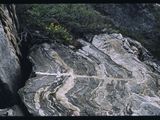And What Step of the Rock Cycle Can Igneous Metamorphic Sedimentary Rocks Become Magma Again
The term "metamorphosis" is almost often used in reference to the process of a caterpillar irresolute into a butterfly. However, the word "metamorphosis" is a broad term that indicates a change from one thing to another. Even rocks, a seemingly constant substance, tin alter into a new type of rock. Rocks that undergo a modify to class a new rock are referred to as metamorphic rocks. In the rock cycle, there are three different types of rocks: sedimentary, igneous, and metamorphic. Sedimentary and igneous rocks began as something other than rock. Sedimentary rocks were originally sediments, which were compacted under high pressure. Igneous rocks formed when liquid magma or lava—magma that has emerged onto the surface of the World—cooled and hardened. A metamorphic rock, on the other paw, began as a rock—either a sedimentary, igneous, or even a different sort of metamorphic rock. Then, due to various conditions within the Earth, the existing rock was changed into a new kind of metamorphic rock. The weather condition required to course a metamorphic rock are very specific. The existing rock must be exposed to high heat, high pressure, or to a hot, mineral-rich fluid. Commonly, all three of these circumstances are met. These atmospheric condition are most frequently found either deep in Earth's chaff or at plate boundaries where tectonic plates collide. In order to create metamorphic rock, it is vital that the existing rock remain solid and not melt. If there is too much oestrus or force per unit area, the rock will cook and become magma. This volition result in the formation of an igneous stone, not a metamorphic rock. Consider how granite changes form. Granite is an igneous rock that forms when magma cools relatively slowly undercover. It is usually composed primarily of the minerals quartz, feldspar, and mica. When granite is subjected to intense oestrus and pressure, it changes into a metamorphic rock called gneiss. Slate is some other common metamorphic rock that forms from shale. Limestone, a sedimentary stone, volition change into the metamorphic rock marble if the right conditions are met. Although metamorphic rocks typically form deep in the planet'due south crust, they are oftentimes exposed on the surface of the World. This happens due to geologic uplift and the erosion of the rock and soil above them. At the surface, metamorphic rocks will be exposed to weathering processes and may break down into sediment. These sediments could so be compressed to class sedimentary rocks, which would start the entire wheel afresh.

Metamorphic rock, estimated to be as one-time equally three.8 billion years, located almost Isua at Qorqut Sound, Greenland.
Photograph by James L. Amos
Noun
rock formed by the cooling of magma or lava.
lava
Noun
molten rock, or magma, that erupts from volcanoes or fissures in the Globe's surface.
Noun
molten, or partially melted, rock below the Earth's surface.
metamorphic rock
Noun
stone that has transformed its chemical qualities from igneous or sedimentary.
Noun
movement and interaction of the Earth's plates.
Substantive
processes that explain the relationship between the iii rock types: igneous, sedimentary, and metamorphic. Whatsoever rock type can get whatsoever other.
Substantive
rock formed from fragments of other rocks or the remains of plants or animals.
uplift
Noun
elevation of the Earth'southward surface due to tectonic or other natural activity.
Source: https://www.nationalgeographic.org/encyclopedia/metamorphic-rocks/
0 Response to "And What Step of the Rock Cycle Can Igneous Metamorphic Sedimentary Rocks Become Magma Again"
Post a Comment